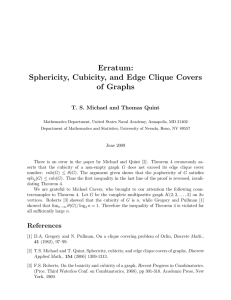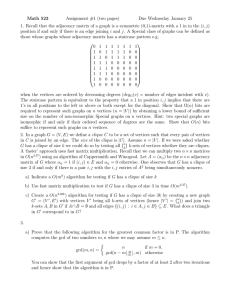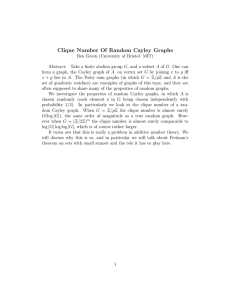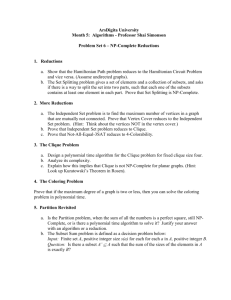Mining market data: A network approach ARTICLE IN PRESS Vladimir Boginski
advertisement
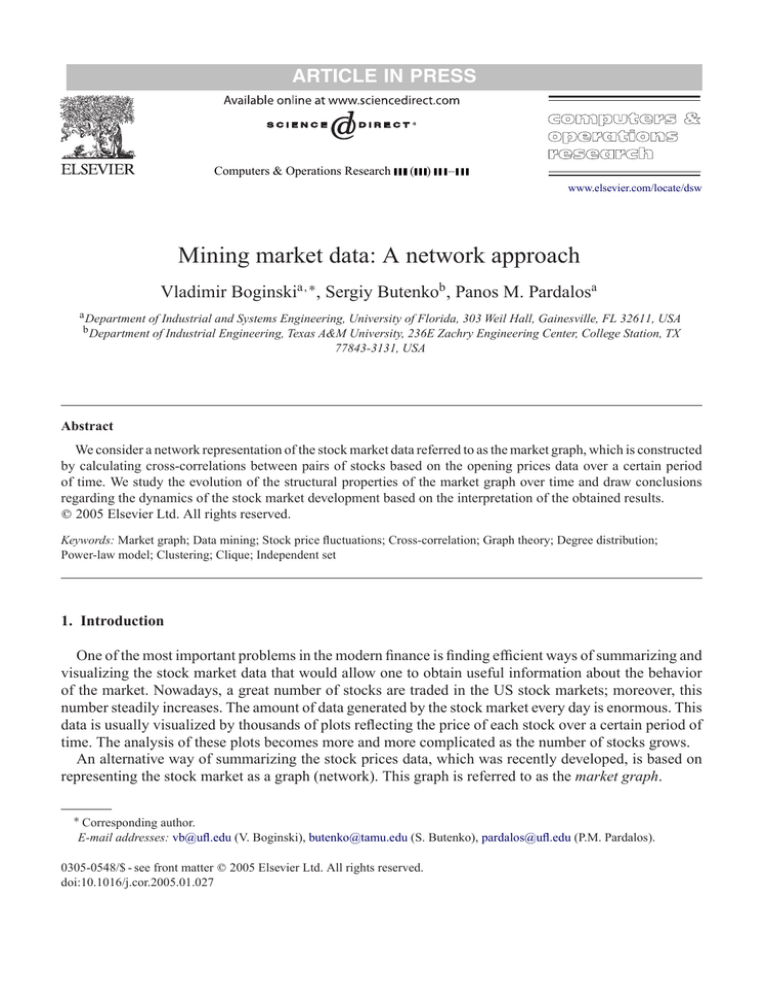
ARTICLE IN PRESS
Computers & Operations Research
(
)
–
www.elsevier.com/locate/dsw
Mining market data: A network approach
Vladimir Boginskia,∗ , Sergiy Butenkob , Panos M. Pardalosa
a Department of Industrial and Systems Engineering, University of Florida, 303 Weil Hall, Gainesville, FL 32611, USA
b Department of Industrial Engineering, Texas A&M University, 236E Zachry Engineering Center, College Station, TX
77843-3131, USA
Abstract
We consider a network representation of the stock market data referred to as the market graph, which is constructed
by calculating cross-correlations between pairs of stocks based on the opening prices data over a certain period
of time. We study the evolution of the structural properties of the market graph over time and draw conclusions
regarding the dynamics of the stock market development based on the interpretation of the obtained results.
䉷 2005 Elsevier Ltd. All rights reserved.
Keywords: Market graph; Data mining; Stock price fluctuations; Cross-correlation; Graph theory; Degree distribution;
Power-law model; Clustering; Clique; Independent set
1. Introduction
One of the most important problems in the modern finance is finding efficient ways of summarizing and
visualizing the stock market data that would allow one to obtain useful information about the behavior
of the market. Nowadays, a great number of stocks are traded in the US stock markets; moreover, this
number steadily increases. The amount of data generated by the stock market every day is enormous. This
data is usually visualized by thousands of plots reflecting the price of each stock over a certain period of
time. The analysis of these plots becomes more and more complicated as the number of stocks grows.
An alternative way of summarizing the stock prices data, which was recently developed, is based on
representing the stock market as a graph (network). This graph is referred to as the market graph.
∗ Corresponding author.
E-mail addresses: vb@ufl.edu (V. Boginski), butenko@tamu.edu (S. Butenko), pardalos@ufl.edu (P.M. Pardalos).
0305-0548/$ - see front matter 䉷 2005 Elsevier Ltd. All rights reserved.
doi:10.1016/j.cor.2005.01.027
ARTICLE IN PRESS
2
V. Boginski et al. / Computers & Operations Research
(
)
–
It should be noted that the approach of representing a dataset as a network becomes more and more
extensively used in various practical applications, finance being one of them [1–6]. This methodology
allows one to visualize a dataset by representing its elements as vertices and observe certain relationships
between them. Studying the structure of a graph representing a dataset is important for understanding
the internal properties of the application it represents, as well as for improving storage organization
and information retrieval. One can easily imagine a graph as a set of dots (vertices) and links (edges)
connecting them, which in many cases makes this representation convenient and easily understandable.
A natural graph representation of the stock market is based on the cross-correlations of price fluctuations. The market graph is constructed as follows: a vertex represents each stock, and two vertices are
connected by an edge if the correlation coefficient of the corresponding pair of stocks (calculated over a
certain period of time) exceeds a specified threshold ∈ [−1, 1].
The formal procedure of constructing the market graph is as follows. Let Pi (t) denote the price of the
instrument i on day t. Then Ri (t) = ln Pi (t)/Pi (t − 1) defines the logarithm of return of the instrument
i over the one-day period from (t − 1) to t. The correlation coefficient between instruments i and j is
calculated as
Ri Rj − Ri Rj Cij = ,
(1)
Ri2 − Ri 2 Rj2 − Rj 2 where Ri is defined simply as the average return of the instrument i over N considered days (i.e.,
Ri = (1/N) N
t=1 Ri (t)) [7].
An edge connecting stocks i and j is added to the graph if Cij , which means that the prices of these
two stocks behave similarly over time, and the degree of this similarity is defined by the chosen value of
. Therefore, studying the pattern of connections in the market graph would provide helpful information
about the internal structure of the stock market.
In our previous research, we have investigated various properties of the market graph constructed using
the data for 500 recent consecutive trading days in 2000–2002 [8,9]. In this work, it has been observed
that the distribution of the correlation coefficients calculated for all possible pairs of stocks using (1) has
the shape similar to a part of a normal distribution with the mean approximately equal to 0.05, and that
for the values of the correlation threshold 0.2 the degree distribution of the market graph follows the
power-law model [2]. According to this model, the probability that a vertex has a degree k (i.e., there are
k edges emanating from it) is
P (k) ∝ k −
(2)
or, equivalently,
log P (k) ∝ − log k
(3)
which shows that this distribution can be plotted as a straight line in the logarithmic scale.
An interesting fact is that besides the market graph, many other graphs arising in diverse areas
[2,3,5,6,10–15] also have a well-defined power-law structure. This fact served as a motivation to introduce a concept of “self-organized networks”, and it turns out that this phenomenon also takes place in
finance.
Another contribution of Boginski et al. [8,9] is in a suggestion to relate some correlation-based properties of the market to certain combinatorial properties of the corresponding market graph. For example,
ARTICLE IN PRESS
V. Boginski et al. / Computers & Operations Research
(
)
–
3
the authors attacked the problem of finding large groups of highly correlated instruments by applying
simple algorithms for finding cliques and independent sets in the market graph constructed using different
values of the correlation threshold.
The main purpose of the present paper is to reveal the dynamics of the changes in structural properties
of the market graph over time. We consider the graphs constructed based on the stock prices data for
different time periods during 1998–2002 and study the evolution of certain characteristics of these graphs.
This approach helps us to obtain useful information about the trends that take place in the modern stock
market.
2. Basic concepts from graph theory and their data mining interpretation
To give a brief introduction to graph theory, we present several basic definitions and notations. We will
also discuss the interpretation of the introduced concepts from the data mining perspective.
Let G = (V , E) be an undirected graph with the set of n vertices V and the set of edges E = {(i, j ) :
i, j ∈ V }.
2.1. Connectivity and degree distribution
The graph G = (V , E) is connected if there is a path from any vertex to any vertex in the set V. If the
graph is disconnected, it can be decomposed into several connected subgraphs, which are referred to as
the connected components of G.
The degree of a vertex is the number of edges emanating from it. For every integer number k one can
calculate the number of vertices n(k) with the degree equal to k, and then get the probability that a vertex
has the degree k as P (k) = n(k)/n, where n is the total number of vertices. The function P (k) is referred
to as the degree distribution of the graph. The degree distribution is an important characteristic of a graph
representing a dataset. It reflects the overall pattern of connections in the graph, which in many cases
reflects the global properties of the dataset this graph represents. As it was indicated above, many reallife massive graphs representing the datasets coming from diverse areas (Internet, telecommunications,
finance, biology, sociology) have degree distributions that follow the power-law model (2).
An important characteristic of the power-law model that should be mentioned here is its scale-free
property. This property implies that the power-law structure of a certain network should not depend
on the size of the network. Clearly, real-world networks dynamically grow over time, therefore, the
growth process of these networks should obey certain rules in order to satisfy the scale-free property. In
[11], the authors point out the necessary properties of the evolution of the real-world networks: growth
and preferential attachment. The first property implies the obvious fact that the size of these networks
continuously grows (i.e., new vertices are added to a network, which means that new elements are added to
the corresponding dataset). The second property represents the idea that new vertices are more likely to be
connected to old vertices with high degrees. The fact that many networks representing different datasets
obey the power-law model indicates that the global organization and evolution of massive datasets arising
in various spheres of life nowadays follow similar laws and patterns.
ARTICLE IN PRESS
4
V. Boginski et al. / Computers & Operations Research
(
)
–
2.2. Cliques and independent sets
Given a subset S ⊆ V , by G(S) we denote the subgraph induced by S. A subset C ⊆ V is a clique
if G(C) is a complete graph, i.e., it has all possible edges. The maximum clique problem is to find the
largest clique in a graph.
The following definitions generalize the concept of clique. Namely, instead of cliques one can consider
dense subgraphs, or quasi-cliques. A -clique C , also called a quasi-clique, is a subset of V such that
G(C ) has at least q(q − 1)/2 edges, where q is the cardinality (i.e., number of vertices) of C .
An independent set is a subset I ⊆ V such that the subgraph G(I ) has no edges. The maximum
independent set problem can be easily reformulated as the maximum clique problem in the complementary
graph Ḡ(V , Ē), which is defined as follows. If an edge (i, j ) ∈ E, then (i, j ) ∈
/ Ē, and if (i, j ) ∈
/ E, then
(i, j ) ∈ Ē. Clearly, a maximum clique in Ḡ is a maximum independent set in G, so the maximum clique
and maximum independent set problems can be easily reduced to each other.
Locating cliques (quasi-cliques) and independent sets in a graph representing a dataset provides important information about this dataset. Intuitively, edges in such a graph would connect vertices corresponding
to “similar” elements of the dataset, therefore, cliques (or quasi-cliques) would naturally represent dense
clusters of similar objects. On the contrary, independent sets can be treated as groups of objects that differ
from every other object in the group, and this information is also important in some applications. Clearly,
it is useful to find a maximum clique or independent set in the graph, since it would give the maximum
possible size of the groups of “similar” or “different” objects.
The maximum clique problem (as well as the maximum independent set problem) is known to be
NP-hard [16]. Moreover, it turns out that these problems are difficult to approximate [17,18]. This makes
these problems especially challenging in large graphs. However, as we will see later, a special structure
of the market graph allows us to get the exact solution of the maximum clique problem.
2.3. Clustering via clique partitioning
The problem of locating cliques and independent sets in a graph can be naturally extended to finding
an optimal partition of a graph into a minimum number of distinct cliques or independent sets. These
problems are referred to as minimum clique partition and graph coloring, respectively. Various mathematical programming formulations of these problems can be found in [19]. Clearly, as in the case of
maximum clique and maximum independent set problems, minimum clique partition and graph coloring are reduced to each other by considering the complimentary graph, and both of these problems are
NP-hard [16]. Solving these problems for the graphs representing real-life datasets is important from the
data mining perspective, in particular, in solving the clustering problem.
The essence of clustering is partitioning the elements in a certain dataset into several distinct subsets
(clusters) grouped according to an appropriate similarity criterion [20]. Identifying the groups of objects
that are “similar” to each other but “different” from other objects in a given dataset is important in many
practical applications. The clustering problem is challenging due to the fact that the number of clusters
and the similarity criterion are usually not known a priori.
If a dataset is represented as a graph, where each data element corresponds to a vertex, the clustering
problem essentially deals with decomposing this graph into a set of subgraphs (subsets of vertices), so that
each of these subgraphs would correspond to a specific cluster. Clearly, since the data elements assigned
to the same cluster should be “similar” to each other, the goal of clustering can be achieved by finding
ARTICLE IN PRESS
V. Boginski et al. / Computers & Operations Research
(
)
–
5
Table 1
Dates and mean correlations corresponding to each 500-day shift
Period #
Starting date
Ending date
Mean correlation
1
2
3
4
5
6
7
8
9
10
11
09/24/1998
12/04/1998
02/18/1999
04/30/1999
07/13/1999
09/22/1999
12/02/1999
02/14/2000
04/26/2000
07/07/2000
09/18/2000
09/15/2000
11/27/2000
02/08/2001
04/23/2001
07/03/2001
09/19/2001
11/29/2001
02/12/2002
04/25/2002
07/08/2002
09/17/2002
0.0403
0.0373
0.0381
0.0426
0.0444
0.0465
0.0545
0.0561
0.0528
0.0570
0.0672
a clique partition of the graph, and the number of clusters will be equal to the number of cliques in the
partition.
3. Evolution of the market graph
In order to investigate the dynamics of the market graph structure, we chose the period of 1000 trading
days in 1998–2002 and considered eleven 500-day shifts within this period. The starting points of every
two consecutive shifts are separated by the interval of 50 days. Therefore, every pair of consecutive shifts
had 450 days in common and 50 days different. Dates corresponding to each shift and the corresponding
mean correlations are summarized in Table 1.
This procedure allows us to accurately reflect the structural changes of the market graph using relatively
small intervals between shifts, but at the same time one can maintain sufficiently large sample sizes of
the stock prices data for calculating cross-correlations for each shift. We should note that in our analysis
we considered only stocks which were among those traded as of the last of the 1000 trading days, i.e.,
for practical reasons we did not take into account stocks which had been withdrawn from the market.
However, these could be included in a more detailed analysis to obtain a better global picture of market
evolution.
3.1. Global characteristics of the market graph: correlation distribution, degree distribution, edge
density
The first subject of our consideration is the distribution of correlation coefficients between all pairs of
stocks in the market. As it was mentioned above, this distribution on [−1, 1] had a shape similar to a
part of normal distribution with mean close to 0.05 for the sample data considered in [8,9]. One of the
interpretations of this fact is that the correlation of most pairs of stocks is close to zero, therefore, the
structure of the stock market is substantially random, and one can make a reasonable assumption that the
prices of most stocks change independently. As we consider the evolution of the correlation distribution
over time, it turns out that the shape of this distribution remains stable, which is illustrated by Fig. 1.
ARTICLE IN PRESS
6
V. Boginski et al. / Computers & Operations Research
(
)
–
0.08
0.07
0.06
0.05
0.04
0.03
0.02
0.01
-1
-0
.9
1
-0
.8
2
-0
.7
3
-0
.6
4
-0
.5
5
-0
.4
6
-0
.3
7
-0
.2
8
-0
.1
9
-0
.1
-0
.0
1
0.
08
0.
17
0.
26
0.
35
0.
44
0.
53
0.
62
0.
71
0.
8
0.
89
0.
98
0
period 1
period 7
period 3
period 9
period 5
period 11
Fig. 1. Distribution of correlation coefficients in the US stock market for several overlapping 500-day periods during 2000–2002
(period 1 is the earliest, period 11 is the latest).
The stability of the correlation coefficients distribution of the market graph intuitively motivates the
hypothesis that the degree distribution should also remain stable for different values of the correlation
threshold. To verify this assumption, we have calculated the degree distribution of the graphs constructed
for all considered time periods. The correlation threshold = 0.5 was chosen to describe the structure of connections corresponding to significantly high correlations. Our experiments show that the
degree distribution is similar for all time intervals, and in all cases it is well described by a power
law. Fig. 2 shows the degree distributions (in the logarithmic scale) for some instances of the market graph (with = 0.5) corresponding to different intervals. As one can see, all these plots can be
well approximated by straight lines, which means that they represent the power-law distribution, as it
follows from (3).
The cross-correlation distribution and the degree distribution of the market graph represent the general
characteristics of the market, and the aforementioned results lead us to the conclusion that the global
structure of the market is stable over time. However, as we will see now, some global changes in the stock
market structure do take place. In order to demonstrate it, we look at another characteristic of the market
graph—its edge density. The edge density of a graph is the ratio of the number of edges in this graph to
the maximum possible number of edges, which is equal to n(n − 1)/2, where n is the number of vertices
in the graph.
In our analysis of the market graph, we chose a relatively high correlation threshold = 0.5 that
would ensure that we consider only the edges corresponding to the pairs of stocks, which are significantly
correlated with each other. In this case, the edge density of the market graph would represent the proportion
of those pairs of stocks in the market, whose price fluctuations are similar and influence each other. The
subject of our interest is to study how this proportion changes during the considered period of time.
ARTICLE IN PRESS
V. Boginski et al. / Computers & Operations Research
number of vertices
number of vertices
1000
100
10
1
10
(a)
100
1000
degree
–
7
1000
100
10
0
10000
1
10
100
1000
degree
10000
1
10
100
1000
degree
10000
(b)
10000
10000
number of vertices
number of vertices
)
10000
10000
0
(
1000
100
10
0
1
(c)
10
100
1000
degree
1000
100
10
0
10000
(d)
Fig. 2. Degree distribution of the market graph for different 500-day periods in 2000–2002 with = 0.5: (a) period 1, (b) period
4, (c) period 7, and (d) period 11.
Table 2
Number of vertices and number of edges in the market graph ( = 0.5) for different periods
Period
Number of vertices
Number of edges
Edge density (%)
1
2
3
4
5
6
7
8
9
10
11
5430
5507
5593
5666
5768
5866
6013
6104
6262
6399
6556
2258
2614
3772
5276
6841
7770
10,428
12,457
12,911
19,707
27,885
0.015
0.017
0.024
0.033
0.041
0.045
0.058
0.067
0.066
0.096
0.130
Table 2 summarizes the obtained results. As it can be seen from this table, both the number of vertices
and the number of edges in the market graph increase as time goes. Obviously, the number of vertices
grows since new stocks appear in the market, and we do not consider those stocks which ceased to exist
by the last of 1000 trading days used in our analysis, so the maximum possible number of edges in the
graph increases as well. However, it turns out that the number of edges grows faster; therefore, the edge
density of the market graph increases from period to period. As one can see from Fig. 3(a), the greatest
increase of the edge density corresponds to the last two periods. In fact, the edge density for the latest
interval is approximately 8.5 times higher than for the first interval! This dramatic jump suggests that
ARTICLE IN PRESS
8
V. Boginski et al. / Computers & Operations Research
0.14%
0.06%
0.04%
80
60
50
40
30
20
10
0.00%
1
(a)
2
3
4
5
6
7
time period
8
9
10
–
70
clique size
0.08%
edge density of the graph
0.10%
)
90
0.12%
0.11%
(
0
11
1
2
(b)
3
4
5
6
7
time period
8
9
10
11
Fig. 3. Evolution of the edge density (a) and maximum clique size (b) in the market graph ( = 0.5).
there is a trend to the “globalization” of the modern stock market, which means that nowadays more and
more stocks significantly affect the behavior of the others.
It should be noted that the increase of the edge density could be predicted from the analysis of the
distribution of the cross-correlations between all pairs of stocks. From Fig. 1, one can observe that even
though the distributions corresponding to different periods have a similar shape and the same mean, the
“tail” of the distribution corresponding to the latest period (period 11) is somewhat “heavier” than for
the earlier periods, which means that there are more pairs of stocks with higher values of the correlation
coefficient.
3.2. Clique and independent set size dynamics in the market graph
In this subsection, we analyze the evolution of the size of the maximum clique in the market graph
over the considered period of time.
Since a clique is a set of completely interconnected vertices, any stock that belongs to the clique is
highly correlated with all other stocks in this clique; therefore, a stock is assigned to a certain group only
if it demonstrates a behavior similar to all other stocks in this group. Clearly, the size of the maximum
clique is an important characteristic of the stock market, since it represents the maximum possible group
of similar objects (i.e., mutually correlated stocks).
A standard integer programming formulation [21] was used to compute the exact maximum clique
in the market graph, however, before solving this problem, we applied a greedy heuristic for finding a
lower bound of the clique number, and a special preprocessing technique which reduces the problem size.
To find a large clique, we apply the standard “best-in” greedy algorithm based on degrees of vertices.
Let C denote the clique. Starting with C = ∅, we recursively add to the clique a vertex vmax of largest
degree and remove all vertices that are not adjacent to vmax from the graph. After running this algorithm,
we applied the following preprocessing procedure [1]. We recursively remove from the graph all of the
vertices which are not in C and whose degree is less than |C|, where C is the clique found by the greedy
algorithm.
Denote by G = (V , E ) the graph induced by remaining vertices. Then the maximum clique
problem can be formulated and solved for G . The following integer programming formulation was
ARTICLE IN PRESS
V. Boginski et al. / Computers & Operations Research
(
)
–
9
Table 3
Greedy clique size and the clique number for different time periods ( = 0.5)
Period
|V |
Edge dens. in G
Clustering
coefficient
|C|
|V |
Edge dens. in G
Clique
no.
1
2
3
4
5
6
7
8
9
10
11
5430
5507
5593
5666
5768
5866
6013
6104
6262
6399
6556
0.00015
0.00017
0.00024
0.00033
0.00041
0.00045
0.00058
0.00067
0.00066
0.00096
0.00130
0.505
0.504
0.499
0.517
0.550
0.558
0.553
0.566
0.553
0.486
0.452
15
18
26
34
42
45
51
60
62
77
84
76
43
49
70
82
86
110
114
107
134
146
0.286
0.731
0.817
0.774
0.787
0.804
0.769
0.819
0.869
0.841
0.844
18
19
27
34
42
45
51
60
62
77
85
used [21]:
maximize
|V |
xi
i=1
s.t.
xi + xj 1, (i, j ) ∈
/ E,
xi ∈ {0, 1}.
It should be noted that in the case of market graph instances with a high positive correlation threshold, the aforementioned preprocessing procedure is very efficient and significantly reduces the number of vertices in a graph [8]. This can be intuitively explained by the fact that these instances of
the market graph are clustered (i.e., two vertices in a graph are more likely to be connected if they
have a common neighbor), so the clustering coefficient, which is defined as the probability that for a
given vertex its two neighbors are connected by an edge, is much higher than the edge density in these
graphs (see Table 3). This characteristic is also typical for other power-law graphs arising in different
applications.
After reducing the size of the original graph, the resulting integer programming problem for finding
a maximum clique can be relatively easily solved using the CPLEX integer programming solver [22]. It
should be also noted that the aforementioned heuristic algorithm was rather efficient: in fact, in 7 out of
11 cases the greedy heuristic was able to find the exact solution of the maximum clique problem.
Table 3 presents the sizes of the maximum cliques found in the market graph for different time periods.
As in the previous subsection, we used a relatively high correlation threshold = 0.5 to consider only
significantly correlated stocks. As one can see, there is a clear trend of the increase of the maximum clique
size over time, which is consistent with the behavior of the edge density of the market graph discussed
above (see Fig. 3(b)). This result provides another confirmation of the globalization hypothesis discussed
above.
Another related issue to consider is how much the structure of maximum cliques is different for the
various time periods. Table 4 presents the stocks included into the maximum cliques for different time
ARTICLE IN PRESS
10
V. Boginski et al. / Computers & Operations Research
(
)
–
Table 4
Structure of maximum cliques for different time periods ( = 0.5)
Period
Stocks included into maximum clique
1
BK, EMC, FBF, HAL, HP, INTC, NCC, NOI, NOK, PDS, PMCS, QQQ, RF, SII,
SLB, SPY, TER, WM
2
ADI, ALTR, AMAT, AMCC, ATML, CSCO,KLAC, LLTC, LSCC, MDY, MXIM,
NVLS, PMCS, QQQ, SPY, SUNW, TXN, VTSS, XLNX
3
AMAT, AMCC, CREE, CSCO, EMC, JDSU, KLAC, LLTC, LSCC, MDY, MXIM,
NVLS, PHG, PMCS, QLGC, QQQ, SEBL, SPY, STM, SUNW, TQNT, TXCC, TXN,
VRTS, VTSS, XLK, XLNX
4
AMAT, AMCC, ASML, ATML, BRCM, CHKP, CIEN, CREE, CSCO, EMC, FLEX,
JDSU, KLAC, LSCC, MDY, MXIM, NTAP, NVLS, PMCS, QLGC, QQQ, RFMD,
SEBL, SPY, STM, SUNW, TQNT, TXCC, TXN, VRSN, VRTS, VTSS, XLK, XLNX
5
ALTR, AMAT, AMCC, ASML, ATML, BRCM, CIEN, CREE, CSCO, EMC, FLEX,
IDTI, IRF, JDSU, JNPR, KLAC, LLTC, LRCX, LSCC, LSI, MDY, MXIM, NTAP,
NVLS, PHG, PMCS, QLGC, QQQ, RFMD, SEBL, SPY, STM, SUNW, SWKS,
TQNT, TXCC, TXN, VRSN, VRTS, VTSS, XLK, XLNX
6
ADI, ALTR, AMAT, AMCC, ASML, ATML, BEAS, BRCM, CIEN, CREE, CSCO,
CY, ELX, EMC, FLEX, IDTI, ITWO, JDSU, JNPR, KLAC, LLTC, LRCX, LSCC,
LSI, MDY, MXIM, NTAP, NVLS, PHG, PMCS, QLGC, QQQ, RFMD, SEBL, SPY,
STM, SUNW, TQNT, TXCC, TXN, VRSN, VRTS, VTSS, XLK, XLNX
7
ALTR, AMAT, AMCC, ATML, BEAS, BRCD, BRCM, CHKP, CIEN, CNXT, CREE,
CSCO, CY, DIGL, EMC, FLEX, HHH, ITWO, JDSU, JNPR, KLAC, LLTC, LRCX,
LSCC, MDY, MERQ, MXIM, NEWP, NTAP, NVLS, ORCL, PMCS, QLGC, QQQ,
RBAK, RFMD, SCMR, SEBL, SPY, SSTI, STM, SUNW, SWKS, TQNT, TXCC,
TXN, VRSN, VRTS, VTSS, XLK, XLNX
8
ALTR, AMAT, AMCC, AMKR, ARMHY, ASML, ATML, AVNX, BEAS, BRCD,
BRCM, CHKP, CIEN, CMRC, CNXT, CREE, CSCO, CY, DIGL, ELX, EMC,
EXTR, FLEX, HHH, IDTI, ITWO, JDSU, JNPR, KLAC, LLTC, LRCX, LSCC,
MDY, MERQ, MRVC, MXIM, NEWP, NTAP, NVLS, ORCL, PMCS, QLGC, QQQ,
RFMD, SCMR, SEBL, SNDK, SPY, SSTI, STM, SUNW, SWKS, TQNT, TXCC,
TXN, VRSN, VRTS, VTSS, XLK, XLNX
9
ADI, ALTR, AMAT, AMCC, ARMHY, ASML, ATML, AVNX, BDH, BEAS, BHH,
BRCM, CHKP, CIEN, CLS, CREE, CSCO, CY, DELL, ELX, EMC, EXTR, FLEX,
HHH, IAH, IDTI, IIH, INTC, IRF, JDSU, JNPR, KLAC, LLTC, LRCX, LSCC,LSI,
MDY, MXIM, NEWP, NTAP, NVLS, PHG, PMCS, QLGC, QQQ, RFMD, SCMR,
SEBL, SNDK, SPY, SSTI, STM, SUNW, SWKS, TQNT, TXCC, TXN, VRSN, VRTS,
ARTICLE IN PRESS
V. Boginski et al. / Computers & Operations Research
(
)
–
11
Table 4 (continued)
Period
Stocks included into maximum clique
VTSS, XLK, XLNX
10
ADI, ALTR, AMAT, AMCC, AMD, ASML, ATML, BDH, BHH, BRCM, CIEN, CLS,
CREE, CSCO, CY, CYMI, DELL, EMC, FCS, FLEX, HHH, IAH, IDTI, IFX, IIH,
IJH, IJR, INTC, IRF, IVV, IVW, IWB, IWF, IWM, IWV, IYV, IYW, IYY, JBL,
JDSU, KLAC, KOPN, LLTC, LRCX, LSCC, LSI, LTXX, MCHP, MDY, MXIM,
NEWP, NTAP, NVDA, NVLS, PHG, PMCS, QLGC, QQQ, RFMD, SANM, SEBL,
SMH, SMTC, SNDK, SPY, SSTI, STM, SUNW, TER, TQNT, TXCC, TXN, VRTS,
VSH, VTSS, XLK, XLNX
11
ADI, ALA, ALTR, AMAT, AMCC, AMD, ASML, ATML, BDH, BEAS, BHH, BRCM,
CIEN, CLS, CNXT, CREE, CSCO, CY, CYMI, DELL, EMC, EXTR, FCS, FLEX,
HHH, IAH, IDTI, IIH, IJH, IJR, INTC, IRF, IVV, IVW, IWB, IWF, IWM, IWO,
IWV, IWZ, IYV, IYW, IYY, JBL, JDSU, JNPR, KLAC, KOPN, LLTC, LRCX, LSCC,
LSI, LTXX, MCRL, MDY, MKH, MRVC, MXIM, NEWP, NTAP, NVDA, NVLS,
PHG, PMCS, QLGC, QQQ, RFMD, SANM, SEBL, SMH, SMTC, SNDK, SPY, SSTI,
STM, SUNW, TER, TQNT, TXN, VRTS, VSH, VTSS, XLK, XLNX
periods. It turns out that in most cases stocks that appear in a clique in an earlier period also appear in the
cliques in later periods.
There are some other interesting observations about the structure of the maximum cliques found for
different time periods. It can be seen that all the cliques include a significant number of stocks of the
companies representing the “high-tech” industry sector. As the examples, one can mention well-known
companies such as Sun Microsystems, Inc., Cisco Systems, Inc., Intel Corporation, etc. Moreover, each
clique contains stocks of the companies related to the semiconductor industry (e.g., Cypress Semiconductor Corporation, Cree, Inc., Lattice Semiconductor Corporation, etc.), and the number of these stocks
in the cliques increases with the time. These facts suggest that the corresponding branches of industry
expanded during the considered period of time to form a major cluster of the market.
In addition, we observed that in the later periods (especially in the last two periods) the maximum
cliques contain a rather large number of exchange traded funds, i.e., stocks that reflect the behavior
of certain indices representing various groups of companies. It should be mentioned that all maximum
cliques contain Nasdaq 100 tracking stock (QQQ), which was also found to be the vertex with the highest
degree (i.e., correlated with the most stocks) in the market graph [8].
Another natural question that one can pose is how the size of independent sets (i.e., diversified portfolios
in the market) changes over time. As it was pointed out in [8,9], finding a maximum independent set
in the market graph turns out to be a much more complicated task than finding a maximum clique. In
particular, in the case of solving the maximum independent set problem (or, equivalently, the maximum
clique problem in the complementary graph), the preprocessing procedure described above does not
reduce the size of the original graph. This can be explained by the fact that the clustering coefficient in
the complementary market graph with = 0 is much smaller than in the original graph corresponding to
= 0.5 (see Table 5).
ARTICLE IN PRESS
12
V. Boginski et al. / Computers & Operations Research
(
)
–
Table 5
Size of independent sets found using the greedy heuristic ( = 0.0)
Period
Number of
vertices
Edge
density
Clustering
coefficient
Independent
set size
1
2
3
4
5
6
7
8
9
10
11
5430
5507
5593
5666
5768
5866
6013
6104
6262
6399
6556
0.258
0.275
0.281
0.265
0.260
0.254
0.228
0.227
0.238
0.228
0.201
0.293
0.307
0.307
0.297
0.292
0.288
0.269
0.268
0.277
0.269
0.245
11
11
10
11
11
11
11
10
12
12
11
Edge density and clustering coefficient are given for the complement graph.
Similar to [8], we calculate maximal independent sets (a maximal independent set is an independent
set that is not a subset of another independent set) in the market graph using the above greedy algorithm.
As one can see from Table 5, the sizes of independent sets found in the market graph for = 0 are rather
small, which is consistent with the results of [8].
The choice of = 0 is rather too extreme for practical purposes, however an independent set found for
this value of could serve as a “base” for forming a diversified portfolio. For example, an independent
set could be extended by adding extra vertices selected in such a way that the resulting set of vertices
is “almost” independent. One possibility is, starting with an independent set I, recursively add a vertex
to I that has no more than k neighbors in I, where k is some small positive integer. The resulting set
would correspond to a (k + 1)-plex in the complement graph. A subset of vertices C of cardinality m
is called a k-plex if it has at least m − k neighbors in C. Note that if k = 1 we obtain the definition of
clique. The concept of k-plex is quite popular in the study of social networks, where a k-plex corresponds
to a so-called cohesive subgroup [23]. Another idea along these lines is to use quasi-independent sets
to represent diversified portfolios. Similarly to a quasi-clique, a -quasi-independent set is defined as a
subset of vertices whose induced subgraph has at most (1 − )q(q − 1)/2 edges.
3.3. Minimum clique partition of the market graph
Besides analyzing the maximum cliques in the market graph, one can also divide the market graph into
the smallest possible set of distinct cliques. As it was pointed out above, the partition of a dataset into
sets (clusters) of elements grouped according to a certain criterion is referred to as clustering.
Clearly, the methodology of finding cliques in the market graph provides an effective tool of performing clustering based on the stock market data. The choice of the grouping criterion is clear and natural:
“similar” financial instruments are determined according to the correlation between their price fluctuations. Moreover, the minimum number of clusters in the partition of the set of financial instruments is
equal to the minimum number of distinct cliques that the market graph can be divided into (the minimum
clique partition problem).
ARTICLE IN PRESS
V. Boginski et al. / Computers & Operations Research
(
)
–
13
Table 6
The largest clique size and the number of cliques in computed clique partitions ( = 0.05)
Period
Number of
vertices
Edge
density
Largest clique
in the partition
# of cliques in
the partition
1
2
3
4
5
6
7
8
9
10
11
5430
5507
5593
5666
5768
5866
6013
6104
6262
6399
6556
0.400
0.377
0.379
0.405
0.413
0.425
0.469
0.475
0.456
0.474
0.521
469
552
636
743
789
824
929
983
997
1159
1372
494
517
513
503
501
496
471
470
509
501
479
For finding a clique partition, we choose the instance of the market graph with a low correlation
threshold = 0.05 (the mean of the correlation coefficients distribution shown in Fig. 1), which would
ensure that the edge density of the considered graph is high enough and the number of isolated vertices
(which would obviously form distinct cliques) is small.
We use the standard greedy heuristic to compute a clique partition in the market graph: recursively find
a maximal clique and remove it from the graph, until no vertex remain. Cliques are computed using the
previously described greedy algorithm. The corresponding results for the market graph with threshold
= 0.05 are presented in Table 6. Note that the size of the largest clique in the partition is increasing
from one period to another, with the largest clique in the last period containing about three times as many
vertices as the corresponding clique in the first partition. At the same time, the number of cliques in the
partition is comparable for different periods, with a slight overall trend towards decrease, whereas the
number of vertices is increasing as time goes.
4. Concluding remarks
Graph representation of the stock market data and interpretation of the properties of this graph gives a
new insight into the internal structure of the stock market. In this paper, we have studied different characteristics of the market graph and their evolution over time and came to several interesting conclusions
based on our analysis. It turns out that the power-law structure of the market graph is quite stable over
the considered time intervals; therefore one can say that the concept of self-organized networks, which
was mentioned above, is applicable in finance, and in this sense the stock market can be considered as a
“self-organized” system.
Another important result is the fact that the edge density of the market graph, as well as the maximum
clique size, steadily increase during the last several years, which supports the well-known idea about the
globalization of economy which has been widely discussed recently.
We have also indicated the natural way of dividing the set of financial instruments into groups of
similar objects (clustering) by computing a clique partition of the market graph. This methodology can
ARTICLE IN PRESS
14
V. Boginski et al. / Computers & Operations Research
(
)
–
be extended by considering quasi-cliques in the partition, which may reduce the number of obtained
clusters.
Acknowledgements
The authors would like to thank Sigurdur Ólafsson for his encouragement and the two anonymous
referees for their constructive comments.
References
[1] Abello J, Pardalos PM, Resende MGC. On maximum clique problems in very large graphs. DIMACS Series, vol. 50.
Providence, RI: American Mathematical Society; 1999. p. 119–30.
[2] Aiello W, Chung F, Lu L. A random graph model for power-law graphs. Experimental Mathematics 2001;10:53–66.
[3] Hayes B. Graph theory in practice. American Scientist 2000;88:9–13 (Part I), 104–9 (Part II).
[4] Jeong H, Tomber B, Albert R, Oltvai ZN, Barabasi A-L. The large-scale organization of metabolic networks. Nature
2000;407:651–4.
[5] Watts D. Small worlds: the dynamics of networks between order and randomness. Princeton, NJ: Princeton University
Press; 1999.
[6] Watts D, Strogatz S. Collective dynamics of ‘small-world’ networks. Nature 1998;393:440–2.
[7] Mantegna RN, Stanley HE. An introduction to econophysics: correlations and complexity in finance. Cambridge:
Cambridge University Press; 2000.
[8] Boginski V, Butenko S, Pardalos PM. On structural properties of the market graph. In: Nagurney A, editor. Innovations in
financial and economic networks. Edward Elgar Publishers; 2003.
[9] Boginski V, Butenko S, Pardalos PM. Statistical analysis of financial networks. Computational Statistics and Data Analysis
2005;48(2):431–43.
[10] Albert R, Barabasi A-L. Statistical mechanics of complex networks. Reviews of Modern Physics 2002;74:47–97.
[11] Barabasi A-L, Albert R. Emergence of scaling in random networks. Science 1999;286:509–11.
[12] Barabasi A-L. Linked. Perseus Publishing; 2002.
[13] Boginski V, Butenko S, Pardalos PM. Modeling and optimization in massive graphs. In: Pardalos PM, Wolkowicz H,
editors. Novel approaches to hard discrete optimization. Providence, RI: American Mathematical Society; 2003. p. 17–39.
[14] Broder A, Kumar R, Maghoul F, Raghavan P, Rajagopalan S, Stata R, Tomkins A, Wiener J. Graph structure in the Web.
Computer Networks 2000;33:309–20.
[15] Faloutsos M, Faloutsos P, Faloutsos C, On power-law relationships of the Internet topology. ACM SICOMM, 1999.
[16] Garey MR, Johnson DS. Computers and intractability: a guide to the theory of NP-completeness. New York: Freeman;
1979.
[17] Arora S, Safra S. Approximating clique is NP-complete. Proceedings of the 33rd IEEE symposium on foundations on
computer science 1992. p. 2–13.
[18] Hȧstad J. Clique is hard to approximate within n1− . Acta Mathematica 1999;182:105–42.
[19] Pardalos PM, Mavridou T, Xue J. The graph coloring problem: a bibliographic survey. In: Du D-Z, Pardalos PM, editors.
Handbook of combinatorial optimization, vol. 2. Dordrecht: Kluwer Academic Publishers; 1998. p. 331–95.
[20] Bradley PS, Fayyad UM, Mangasarian OL. Mathematical programming for data mining: formulations and challenges.
INFORMS Journal on Computing 1999;11(3):217–38.
[21] Bomze IM, Budinich M, Pardalos PM, Pelillo M. The maximum clique problem. In: Du D-Z, Pardalos PM, editors.
Handbook of combinatorial optimization. Dordrecht: Kluwer Academic Publishers; 1999. p. 1–74.
[22] ILOG CPLEX 7.0 Reference Manual, 2000.
[23] Wasserman S, Faust K. Social network analysis: methods and applications. Cambridge: Cambridge University Press; 1994.



